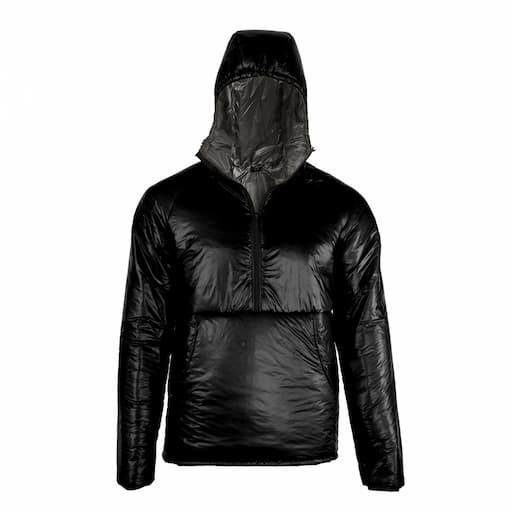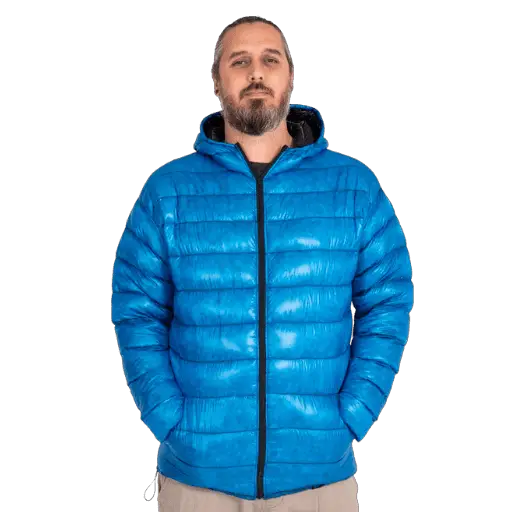There are two options for staying warm on the Appalachian Trail: down or synthetic. Synthetic jackets are more affordable, but they don’t offer the same compression in a backpack as a down jacket.
The real question is whether a down or synthetic jacket is better for a thru-hike on the Appalachian Trail.
There are two options for puffer jackets that a thru-hiker can purchase: a standard down and a synthetic down jacket. Down has more compressibility and is lighter in overall weight for similar warmth, whereas a synthetic insulated jacket handles moisture and maintains warmth regardless of moisture levels.
The choice is easy when looking for an ultralight jacket as this will always be down, but your environment matters.
If your hike is in a wet environment, that should be a large part of the deciding factor when you choose between down or synthetic.
Down vs. Synthetic Jackets for Backpacking
This battle is nearly as old as time; the largest part is firmly entrenched in down as the best choice for backpacking, typically due to being the lightest jacket.
There are good reasons for this, and there is a place specifically where synthetic wins out every time, which is wet conditions.
Why Choose Down For Thru-Hiking The AT?
Down has long been one of the best options for warmth and for lower weight, but it does come with some significant downsides due to being natural. An example is below with the Goose Down Jacket by Zpacks.
Down is very compressible and packs down to a small size, making it easy for thru-hikers to fit into their backpack.
Down jackets are also typically lighter than synthetic jackets of the same warmth rating, making them more comfortable on the trail and easier to carry when not worn.
Down jackets are also typically more expensive than synthetic options, but they can last a very long time when taken care of properly, making the cost per wear cheaper.
The biggest reason people choose down is that it is warmer for its weight over synthetics, which makes them excellent choices for cold conditions or low-exertion activities.
Down can have issues, though with jacket loft failing over time as they pick up bodily oils from being worn, which reduces their insulation.
This is why it’s essential to wash your down jacket regularly with a special cleaner or cold water, and if you want the best performance, drying them in a dryer on no or low heat can help restore some of that lost loft.
Why Synthetic Jackets Excel In Certain Situations
The biggest reason to choose a synthetic puffer jacket is that it can handle moisture well and retain warmth. An example of APEX synthetic fabric is shown below: the Enlightened Equipment Torrid Pullover.
This makes synthetic choices much better for wet conditions than a down jacket when the risk of being both cold and wet is high, as well as the difficulty with drying out properly, which can lead to mold and mildew.
A synthetic jacket like either the Patagonia Micro Puff or Nano Puff is also typically less expensive, which can make them a better choice for those on a budget or looking for their first puffer jacket as you won’t have to worry quite as much about taking care of it down the road.
Synthetic jackets are not compressible at all, meaning that it will take up a good amount of space in your backpack and fill it up more easily than down.
These jackets are typically heavier as well, but they pack into their own pocket, making them easier to clip onto the outside of a pack rather than having additional straps like down options.
Key Factors To Consider For Your Needs
For me, as long as you take good care of down gear, it will last far longer, decades, than a synthetic. Synthetics break down over time as they are compressed, and the insulation breaks down.
Since a thru-hike will be less than six months on average, the down jacket makes far more sense overall. There are a few reasons why someone may decide to instead focus on synthetic insulation.
Let’s go over some of the reasons why you focus on synthetic insulation:
Ideological Ideals – Are You Vegan?
If you are against animal use, as a vegan, for example, your only choice will be to use a synthetic jacket.
This is because Down uses the feathers of geese and ducks, often live-plucked, to get them to fill a jacket correctly.
There isn’t much cruelty involved in how companies obtain their materials, but it does give some people pause when they think about how we use animals for our purposes, including warmth.
The AT: Where Rain Is Your Consistent Companion
Another reason you need to look more deeply at synthetic-based puffy jackets is because you will be in wet conditions.
Since your journey takes you through some of the wettest areas where it rains almost daily, then down insulation doesn’t hold up against that moisture and retains warmth as a synthetic jacket would.
Are Weight and Packability vital to you?
Synthetics’ big downfall in a head-to-head battle is its high overall weight and lack of compression.
These two factors are crucial for thru-hikers as you want to carry the least weight in gear possible.
In addition, you need this gear not to take up too much space in your backpack, as it can be viewed as mission-critical that you conserve every inch of space.
What Will Your Activity Level Be?
The last benefit to a synthetic will be that due to the insulation being artificial, it can get wet from sweat and exertion while not losing heat, allowing you to dry it later.
This means you can hike in the rain while wearing it under a rain jacket or other rain gear and not worry about your insulation getting wet on a wet-out.
Sometimes, that little bit of extra warmth is all you need not to feel that urge to quit and to get yourself through another day on the trail.
Available Money For Gear
The last big deal for many hikers will be the gear cost. A synthetic jacket is typically far less expensive than a high-quality down insulation option like 800-fill goose or duck down that you can get on the market today.
This means that many hikers will try to save money and buy these cheaper synthetic puffer jackets instead of spending more upfront for an ultralight down jacket, which can be $400 or more.
The counter to this is that the down jackets are typically lighter, compressible, and offer better warmth-to-weight ratios on average than synthetics.
However, this is changing as new materials emerge that change the game.
Top Pick For Ultralight Backpacking Warmth

Enlightened Equipment Torrid Pullover
The Torrid Pullover takes their best-selling Torrid Jacket and adds handy new features for thru-hikers. This pullover style has a marsupial pouch and 1/2 length zipper, providing easy access to the insulation without the full zipper weight.
- Marsupial front pouch (insulated on both sides).
- 1/2 front zipper for ventilation.
- Built with no sewn-through seams to eliminate cold spots.
- Raglan style sleeves to increase comfort and range of motion.
- Elastic cuffs.
- Adjustable shock cord waist, tucked inside front pouch.
- Adjustable shock cord hood.
If you are more interested in down, then the best performance is below:

Zpacks Goose Down Jacket
Stay warm and comfortable on those chilly nights in the backcountry with the Zpacks Goose Down Jacket. This ultimate, ultralight, Goose Down Jacket strikes the ideal balance of warmth and weight, appealing to outdoor enthusiasts seeking to stay warm at an incredible weight!
- Both the liner and the shell are treated with C0 durable water repellent to resist rain spray and body moisture.
- Comfortable body and sleeve length provide warmth over layers.
- Fitted hood with adjustable cinch cords provides maximum coverage.
- Dual hand pockets help you stay warm on trail or at camp.
- Adjustable elastic at the hem can be cinched tight to prevent the jacket from riding up.
- Elastic at the wrists seals the sleeves and keeps drafts out.
In Summary
Down jackets are typically better in the long run than synthetic ones because they last decades and have a better warmth-to-weight ratio.
However, a synthetic jacket is your best bet if you’re vegan or hiking through consistently damp areas where it rains almost daily.
Synthetic also has drawbacks to their general weight and packability, so consider that when deciding. Check out my choice of best down jackets for thru-hiking here.
The bottom line is to do what’s right for YOU!



Leave a Comment